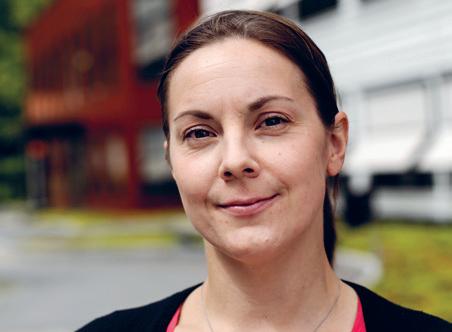
3 minute read
Corona hope with Anna
New corona hope with old finding
– Göteborgs universitet är det enda lärosäte som jag hade kunnat lämna Lund för. UGOT Challenges, arbetet för flyktingar och en hållbar utveckling samt allt övrigt samhällsengagemang hör till de saker jag verkligen uppskattar.
Advertisement
Det förklarar Eva Wiberg som efter visst tumult nu föreslås som ny rektor.
ANNA LUNDIN’S doctoral thesis describes three promising substances for treating RSV, as well as a promising substance for treating the coronavirus. – RSV and coronavirus are two of the most common causes of respiratory infection, says Anna Lundin. The virus creates small cavities in the cytoplasm that are kind of virus factories that use the cell’s own defence mechanisms. In my thesis, I was able to show for the first time that the virus protein nsp6 plays an important role in creating this factory.
By screening tens of thousands of molecules, the research team managed to find one substance, K22, which in cell culture inhibits the formation of these cavities and thus disrupts the virus factory. The cell cultures were produced in a structure that is similar to the one in the trachea.
– LIVING CELLS FROM the respiratory tract were infected with coronavirus, whereupon a group of cells was treated with K22, while another group were given a placebo. K22 turned out to be very effective against the type of coronavirus that we looked at, which causes cold symptoms, but it also looked promising against the MERS virus.
Virology involves several challenges. Among other things, the virus mutates quickly, leading to genetic changes, says Anna Lundin.
– ANTIVIRAL TREATMENTS also put pressure on the virus to change further. For this reason, it is challenging to find substances that will work in the long term, preventing the virus’s resistance from activating too quickly. The interaction between the virus and the host organism is incredibly complex, which has become apparent in the Covid-19 pandemic. We still do not have answers to why some people become fatally ill from the virus, while others barely notice its presence. Certain risk groups have been identified, but it is important to investigate why people who are not in these groups can also become severely ill.
There are currently no drugs for treating coronavirus. One reason for this is that, for a long time, virology has had difficulty attracting research funding. For example, Anna Lundin was not given an opportunity to continue her research. Instead, she is currently working for a company that assesses pharmaceutical safety. – Hindsight is always 20/20, but if research funding had been available earlier, we would have had
Already in 2013, Anna Lundin showed that the substance K22 has a good effect on coronavirus.
ANNA LUNDIN
Photo: JOHAN WINGBORG a much clearer picture of how the coronavirus works and we would be better prepared to handle the current situation. However, over the past six months, there has been intense research within the field, not least here in Gothenburg. The collaboration between the Institute of Biomedicine and the Sahlgrenska University Hospital is proving very beneficial and the possibilities of going from research to implementation are extremely good.
The researchers currently studying Covid-19 include Anna Lundin’s former supervisor, Associate Professor Edward Trybala, her second supervisor, Professor Tomas Bergström, as well as Associate Professor Kristina Nyström.
THEIR TASKS INCLUDE reviewing a library of 1,500 substances that have already been tested to see if any of them are effective against the virus that causes Covid-19. – Among the substances we are studying, there is one psychotropic substance that has substantial structural similarities to K22, says Tomas Bergström. In our cell tests that molecule is working very well against Covid-19. So, after a seven-year hiatus, Anna’s research findings are again very much in the limelight.
Eva Lundgren
Facts
Anna Lundin’s doctoral thesis
from 2013, Candidate antivirals for treatment of respiratory syncytial virus and coronavirus infections, describes three promising substances against respiratory syncytial virus (RSV) as well as a promising substance against the coronavirus.










